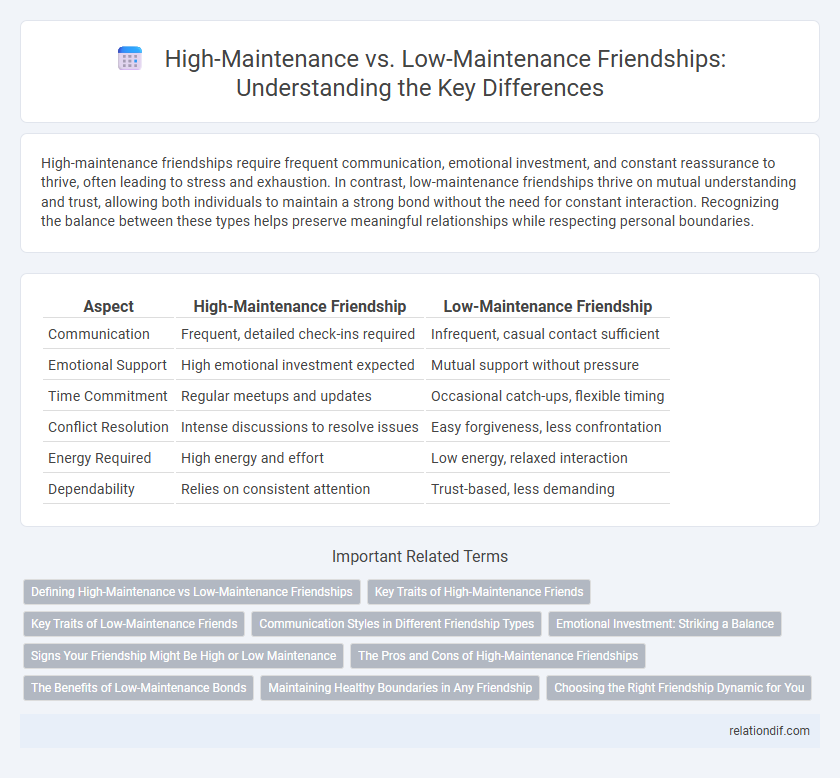High-maintenance friendships require frequent communication, emotional investment, and constant reassurance to thrive, often leading to stress and exhaustion. In contrast, low-maintenance friendships thrive on mutual understanding and trust, allowing both individuals to maintain a strong bond without the need for constant interaction. Recognizing the balance between these types helps preserve meaningful relationships while respecting personal boundaries.
Table of Comparison
| Aspect | High-Maintenance Friendship | Low-Maintenance Friendship |
|---|---|---|
| Communication | Frequent, detailed check-ins required | Infrequent, casual contact sufficient |
| Emotional Support | High emotional investment expected | Mutual support without pressure |
| Time Commitment | Regular meetups and updates | Occasional catch-ups, flexible timing |
| Conflict Resolution | Intense discussions to resolve issues | Easy forgiveness, less confrontation |
| Energy Required | High energy and effort | Low energy, relaxed interaction |
| Dependability | Relies on consistent attention | Trust-based, less demanding |
Defining High-Maintenance vs Low-Maintenance Friendships
High-maintenance friendships require frequent communication, emotional support, and considerable time investment to maintain a strong bond, often involving complex dynamics or expectations. Low-maintenance friendships thrive on mutual understanding with minimal interaction, allowing for flexible connection despite infrequent contact. Defining these friendships involves assessing the level of effort, emotional energy, and consistency needed to sustain the relationship over time.
Key Traits of High-Maintenance Friends
High-maintenance friends often require frequent communication, emotional support, and validation, demanding significant time and energy. They may exhibit traits such as intense neediness, sensitivity to criticism, and high expectations for attention and involvement. These characteristics can lead to stress in the friendship, as maintaining balance becomes challenging for those involved.
Key Traits of Low-Maintenance Friends
Low-maintenance friendships are characterized by mutual understanding, trust, and effortless communication, allowing both parties to reconnect without constant check-ins. These friends respect personal boundaries and demonstrate consistent support without demanding excessive time or emotional energy. Key traits include reliability, acceptance of imperfections, and the ability to enjoy quality moments without the pressure of frequent interaction.
Communication Styles in Different Friendship Types
High-maintenance friendships often demand frequent communication and detailed updates, reflecting emotional intensity and a need for constant reassurance. Low-maintenance friendships thrive on more relaxed communication patterns, where occasional check-ins and brief messages suffice to maintain the bond. These differing communication styles mirror the underlying expectations and energy investments unique to each friendship type.
Emotional Investment: Striking a Balance
High-maintenance friendships require significant emotional investment, often involving frequent communication and constant reassurance, which can lead to emotional exhaustion if not balanced properly. Low-maintenance friendships thrive on mutual understanding and trust, allowing both friends to connect meaningfully without the need for continuous interaction. Striking a balance between these types ensures emotional well-being by fostering supportive connections that respect individual boundaries and energy levels.
Signs Your Friendship Might Be High or Low Maintenance
Signs your friendship might be high-maintenance include frequent demands for attention, constant need for emotional support, and a pattern of drama or conflict that requires substantial effort to resolve. Low-maintenance friendships typically feature mutual understanding, ease of communication without the need for constant check-ins, and a natural flow that doesn't demand excessive time or emotional investment. Recognizing these signs can help balance your social circle and maintain healthier, more fulfilling relationships.
The Pros and Cons of High-Maintenance Friendships
High-maintenance friendships often provide deep emotional support and strong loyalty, fostering meaningful connections that can enhance personal growth and resilience. However, these relationships may demand significant time, energy, and emotional investment, sometimes leading to stress or imbalance in other areas of life. Balancing the benefits of intense support with the potential for burnout is crucial to maintaining healthy high-maintenance friendships.
The Benefits of Low-Maintenance Bonds
Low-maintenance friendships offer consistent emotional support with minimal effort, promoting long-lasting bonds that withstand life's changes. These relationships reduce stress by requiring less frequent communication while still providing trust, understanding, and mutual respect. The stability of low-maintenance friendships enhances well-being through dependable connection without demanding constant attention.
Maintaining Healthy Boundaries in Any Friendship
High-maintenance friendships often require constant communication and emotional investment, which can blur personal boundaries and lead to burnout. Low-maintenance friendships prioritize mutual respect and understanding, allowing each person to maintain independence while staying connected. Establishing healthy boundaries in any friendship ensures emotional well-being and fosters long-lasting, balanced relationships.
Choosing the Right Friendship Dynamic for You
High-maintenance friendships require frequent communication, emotional investment, and regular attention, often bringing intense support but also potential stress. Low-maintenance friendships thrive on mutual trust and understanding, allowing for long intervals without contact while maintaining a strong bond. Choosing the right friendship dynamic depends on your personal energy levels, lifestyle, and emotional needs to ensure a balanced and fulfilling social connection.
High-maintenance friendship vs Low-maintenance friendship Infographic

 relationdif.com
relationdif.com